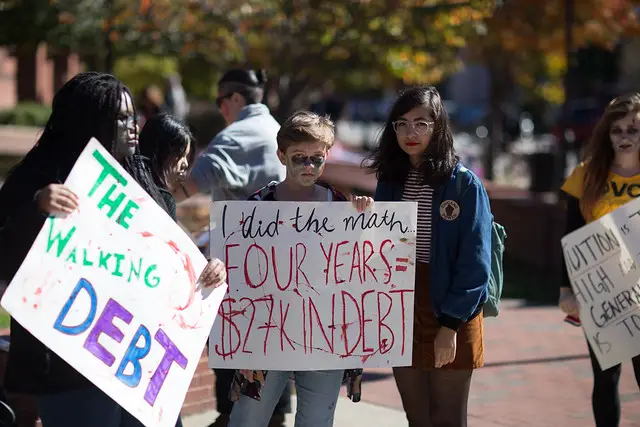Student loan debt in the United States is a growing problem evaluated at $1.6 trillion, or more than $29,000 per person. It has prompted think tanks and politicians across the ideological spectrum to propose a wide range of possible solutions to the student debt crisis.
Driving Up The Cost of Higher Education
“A college degree is now often perceived as the minimum educational attainment for a middle-class life,” Georgetown Law Professor Adam Levitin told The College Post. “Higher education costs have increased…particularly since 1980 and the biggest factor is simply that there’s an increased demand for higher education.”
According to Levitin, however, there are some other cost drivers for higher education as well. One is that colleges and universities are hiring more faculty and structural personnel to meet the increased demand for higher education, leading to greater labor costs. Other reasons include a decrease in state government support for higher education and to a lesser extent rising facility costs as universities compete for students by funding extracurricular amenities.
Senior Research Fellow Dubravka Ritter, who spoke during a Brookings Institution briefing in Washington on October 7, said that taking out student loans also carries risks of repayment problems for borrowers and students from disadvantaged backgrounds bear the brunt of these poor outcomes.
“Borrowers can struggle with repayment due to low or unreliable earnings,” Ritter said. “They can also experience unexpected bad shocks which are not easily predictable at the individual level. Complexities and administrative efficiencies in our repayment system can render borrowers in suboptimal repayment plans and make navigating repayment a source of significant stress for families.”
How Student Debt Affects the Economy
Although student loan debt may not be a problem for everyone, particularly those who have already paid off their student loans or those who choose not to attend college, student debt has substantial effects on the economy, which can have repercussions for everyone. One example of this is the way student debt disincentivizes students from entering the housing market after college.
Between 2005 and 2014, homeownership for those between the ages of 24 and 32 dropped almost 9 percent according to the Federal Reserve, which estimated 20 percent of that decline is attributable to student loan debt in January.
“Student loan debt is delaying entry into the housing market for some people and affecting not only the student loan debtors but everyone who’s a homeowner by pushing down home prices,” Levitin said. “Even if you think ‘Hey I paid off my student loan…why should these millennial brats get a break,’ It’s because when millennials get their student loan debt reduced, you’re going to benefit too in terms of your home price going up.”
Policy Solutions to Student Loan Debt
The cost of higher education has been a major issue of contention on the campaign trail in 2020. Presidential candidates like Bernie Sanders and Elizabeth Warren drafted plans earlier this year for tuition-free college and student debt cancellation.
“There’s already a lot of forgiveness baked to the potential and potentially the system and the public service student loan forgiveness program is incredibly, incredibly generous,” Levitin said. “Senator Warren’s proposal…would probably wipe out 90 to 95% of the student loan debt. That’s totally feasible. The only feasibility question is a political one. As a society are we willing to pay for it?”
Proposals like student debt forgiveness and tuition-free college have drawn sharp criticism from conservatives like Senator Rick Scott of Florida who in September accused Democrats of proposing policies that would “bankrupt the country” to win an election. Instead, Scott offered a proposal of his own called “Skin in The Game” which would make universities partially responsible when students default on their loans.
During the Brookings Institution’s briefing panelists spoke about proposals to cancel student loan debt and make college tuition-free but also offered more modest ideas and tweaks to the federal student loans program.
“We can’t think about free college as just a free thing…we have to think about how we’re funding it,” Principal Economist at the Federal Reserve Board Laura J. Fieveson said. “I believe there’s a way to structure this that would be really good for the economy…At some point though, we have to cross the line. Certainly, no one would say we should have free college from the age of 20 to 50 and then they can enter the workforce.”
Urban Institute Vice President Matthew Chingos suggested not lending to students attending institutions or programs with weak outcomes in the labor market or loan repayment, reinstating limits on graduate student borrowing which were lifted in 2005, and giving institutions discretion to raise those limits on a case by case basis.
How is Student Loan Debt Threatening Students? An Interview With Robin Howarth



